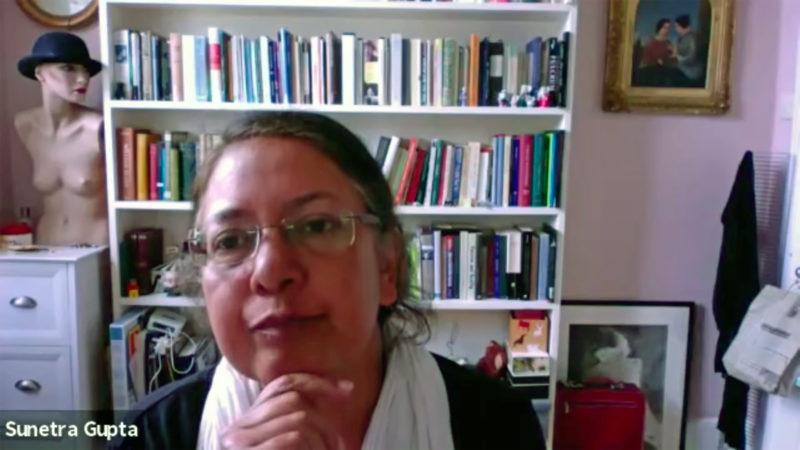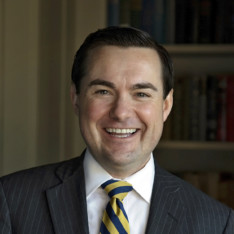Lockdowns are Cruel and Regressive, says Oxford University’s Professor Sunetra Gupta

Oxford University Professor Sunetra Gupta has been an outspoken voice for calm, science, and rationality in dealing with this virus. In the interview below, she explains the basics of immunology, the high costs of mandated closures and restrictions, and maps out a more humane path. Born in Calcutta, she studied biology at Princeton University and completed her PhD at Imperial College London, writing her dissertation on the transmission dynamics of infectious diseases. She is widely published on the topic, and has been an outspoken critic of the bad modelling that inspired the worldwide lockdowns.
Below is a transcript of the following interview.
Let’s talk about these mythologies, which are local and, of course, have also become global.
Myth number one is the idea that we can keep it out, whether at a local level or at a global level. Lockdown has been instituted, of course, in New Zealand and many other parts of the world with actually three different purposes. There are three species of lockdown. There’s a lockdown that attempts to keep the virus in, and I think the original lockdowns in Wuhan and indeed in Northern Italy were implemented with that purpose, which can be thought of as a fairly noble purpose. That is to say, we will make the sacrifices that are necessary to prevent a bug, about which we don’t know enough, which could be lethal, from spreading out of our locality.
That has a long history, and there are accounts of this village called Eem in North Yorkshire, where in the 17th century a plague occurred. They made this collective, communitarian decision to shut down to stop it spreading. And it worked apparently.
Or even if it didn’t work, it’s clearly something to be lauded. It’s something we might expect a responsible citizen to do, and maybe in those times it might have worked. But obviously in these times, with the connectivities between different regions across such long distances, it’s not something that is very likely to work. And particularly with Covid—which is, first of all, largely asymptomatic in people, and then, even in those who have symptoms, a lot of the transmission occurs before those symptoms are evident—it really wasn’t something that we could do. But that’s among the species of lockdown it’s one that one can understand.
Then there’s the kind of lockdown that has been implemented in New Zealand—until recently, apparently quite successfully, to keep it out. And that is also very, very tricky with a pathogen like this, which is so highly infectious. And then the other dimension of it that doesn’t get commented on is whether it’s ethical: Is it ethical to try and keep something out at a national level? Is it okay to operate at a national level—to say, “We are going to shut our borders; we’re not going to let it in; we’re going to protect ourselves”?
Is that really something that is either sustainable or ethical? It can only obviously be sustainable if some sort of mitigation of this threat occurs, which can either occur through other people becoming immune or if a vaccine is developed. And to keep yourself locked down until such a time, I think it is a questionable strategy from an internationally ethical [perspective]. Whether it conforms to what I would consider to be an international ethic is something I think should be discussed and isn’t.
And then the third species of lockdown is one where it’s there and you try and do something to stop it from killing as many people as it might kill.
How can we understand whether any of these things make sense? The way we’ve been trying to look at it, and one of the tools that we have at our disposal for understanding whether these measures make any sense, is the mathematical model. And there is a very standard mathematical model, which is basically what everyone’s been using. People have been using different forms of it. Some are more complicated than others. But essentially at the heart of each is this very simple SIR [Susceptible, Infectious, or Recovered] model, which is a compartmental framework in which people are either susceptible, infected, or recovered.
Very, very simple. It’s like a structure in which you have boxes in which people go and then plumbing to take people from one box to the other. People go from being susceptible to being infected by becoming infected at a rate which is here represented by the symbol λ. Then people recover and then exit from the infected box into the recovered box. This is a metaphor, a model for what happens with diseases like coronavirus, where once you recover you remain uninfectable—at least for the time being. And you can study the dynamics of these diseases by writing down a set of equations corresponding to this structure.
When you do that, what happens is that if you start off with a fully susceptible population, and you introduce an infected individual, the infections will at first take a while, but then there’s a period when they grow but a very slow rate. And then they suddenly increase, and as they increase, the bug is munching through the susceptible population. And there comes a point where actually the pathogen runs out. The number of susceptibles keeps declining.
There comes a point, which we call this herd-immunity threshold, where there are sufficient numbers immune that the numbers infected can no longer start to increase, and they start to decline, and eventually they drop off. Meanwhile, the numbers who are immune or recovered start to grow and then will plateau at a particular point within a particular time frame of the first phase of this infectious-disease event following the introduction of it.
One of the critical parameters that determines the magnitude of any of these peaks is something known as the R0 of the pathogen—its fundamental transmission potential—a combination of parameters that are linked to transmission and how quickly an individual stops being infectious—in other words, the recovery rate, σ. This is the fundamental framework that we use to try and figure out what’s going to happen with an epidemic of this kind.
What can we use this model to say? The first thing that becomes obvious is that it is very, very difficult at this stage—when it is silently growing in numbers—to know that it is present in the population. Secondly, we know that it is going to munch through susceptibles, that there does come a point where it will turn over and go away.
One thing that’s been missing again in the discussions about this pandemic is that this is a dynamic system; it is a system that includes us. What happens to this disease depends on how many of us are immune in a population—how many of us cannot be infected. It is not an independent event.
It’s not like a tsunami or a hurricane or a tornado or something that is external to us. We can’t simply batten down our hatches and wait for it to pass. We are in an interactive state with this bug. The fate of this bug is determined by our continuous response to it. The degree to which we develop immunity is crucial to the fate of this pathogen. We cannot simply wait it out. If we wait it out, we remain in this state of complete susceptibility and therefore are continuously available as a resource for the bug. That’s the first lesson to be learnt.
Second lesson is that once sufficient people are immune, it will turn around and go away for the time being. Of course, what I haven’t plotted is what happens in the future when people start to lose their immunity, either because they’re naturally losing the immune responses that protect them against it or, even if immunity is lifelong, new people are born into the population so eventually the bug does come back for a second wave, which is smaller than the first. Eventually what happens is it settles into what we call an endemic equilibrium. And that is the most likely outcome, most likely fate of SARS-CoV-2.
But what can we do in the short term with this sort of a model? What can we do now? For one thing, we can infer from what we know to be the duration of infection and the possible R0 of this bug that the natural time course of this epidemic is really a couple of months. If you let it run its course, it should be over within two or three months. We know that from this.
Then the question is: how many people will die in that period of time? That we can also infer. That’s what people have done from this model, simply by saying, “Let’s assume that a fraction of those infected will die.” Naturally, that depends on what you use as that parameter—the infection fatality rate, the fraction of people who die upon infection. If you use an infection fatality rate which is closer to 1 percent, you’ll get a quite large number of people dying, as was predicted by the Imperial College modelers, who said half a million people might die in the UK over the course of this pandemic.
However, if you assume that the infection fatality rate is closer to 0.04 percent—if it is more like four in ten thousand—then you get a much, much lower cumulative mortality.
Which of these actually fits the data, the truth? In March, when the UK government locked down, they assumed that this top projection was the correct projection based on the cumulative deaths that one had observed up to that point. But what we did is we put on the table this fact that actually they all do from the data that we had up to the 24th of March. There was no way to tell what was going to happen—whether we were going to have a really high cumulative mortality or a low cumulative mortality—because we did not have sufficient data to pin down the infection mortality rate. And indeed there were scenarios that were equally compatible with this data, including the Imperial College scenario, where you had a very high cumulative projected mortality, which was predicated on the idea that the epidemic had only just started and hadn’t infected too many people and a large fraction of those had already died.
That was one scenario, but another, equally possible scenario was that the epidemic had arrived much earlier—sometime in January or started to take off sometime in January—and that a significant proportion of the population had already been infected and only a small proportion had died. Both of these extremes and anything in between, we showed, was actually compatible with the data. That meant that we didn’t actually know what was going to happen at that point.
Myth number two, which continues to prevail, is that we are all going to die. One of the things that was already clear by then, which contradicts that, even though we didn’t have an idea of what the overall infection fatality rate was, is that the infection fatality rate was not distributed evenly across age classes. It was very, very low—indeed, almost no deaths—in children and teenagers and really quite low in anybody under 65. That was already evident at that time that the UK locked down. What that means is that we can’t really use that very, very simple SIR framework to inform our decisions completely because what we at the very least need to do is consider that there is this vulnerable fraction of the population in which deaths will occur.
What we really have are two systems which are linked by virtue of how they mix with each other and which will have quite different dynamics in terms of what the transmissibility of Covid is within a general population as opposed to a vulnerable population and which can lead to different dynamics in these different populations. You could have a situation where in the general population you get a kind of spread which you hardly notice because the symptoms are so similar to many other symptoms of cold and other, even more severe respiratory illnesses. You could have an epidemic that’s already spread and petered out already, followed by a more visible one in the vulnerable population.
Alternatively, if the vulnerable population has been infected earlier, and if it spread earlier within the vulnerable population, you could have a scenario where it peaks in the vulnerable population much earlier and has yet to spread through the general population. But you can have a variety of scenarios where you will not see in a second wave, for example, the kind of deaths that you see in the first wave.
What we stressed at that point is, given these subtleties, that the only way we’re going to be able to get a sense of who’s going to die and how we need to manage the epidemic is by determining the levels of exposure in these different populations. So, in my lab, Craig Thompson, who runs the laboratory, set out and immediately developed a test to look for antibodies in individuals as a marker of who’d been exposed. This is something that many other research groups also undertook. Also people were going out to see who was infected at all and trying to infer from that also how far it had spread in populations. That’s what we all started to do, although not necessarily in a very joined-up way, in March. And it has been a long slog.
The truth is we still don’t have a very good idea of who has actually been exposed, for two reasons. One is that we’ve been focusing too much on how many cases there are, which is not because you are only PCR positive [active infection] or you only carry the bug for a particular finite period of time. That doesn’t give you a good sense of whether you’ve already had the infection.
Secondly, and rather disappointingly for us, some of the tests that are normally very useful for infections like flu, where you look at the presence of antibodies in people to see if they’ve been exposed, are not doing the same job in Covid because people don’t seem to make antibodies as well and those antibodies don’t last for as long. The levels of seroprevalence, which is to say the proportion of people with antibodies in their blood, that we’ve been observing does not seem to indicate that it’s spread as widely as one might have hoped, which would give you the very, very low infection fatality rates, which would give us the all clear for going ahead and abandoning all measures to protect people from death.
However, there is a third piece. The results of these studies to look for how many people have been exposed are typically returning values that people do not expect to be at the level of where you would get enough immunity in the population to prevent it from spreading.
That leads to myth number three, which is a statement that is very widely and indiscriminately thrown around, that we’re nowhere close to herd immunity. This is very irresponsible. Actually, this statement is being made on the basis of a very simple calculation which is based on an SIR model, again with no heterogeneity in either exposure or in resistance or in vulnerability to infection. A number of fascinating new studies are showing that with this new virus, many of us actually have resistance either from previous exposure to circulating seasonal coronaviruses or due to better innate immune responses or because of structural features such as not having the right receptor for the virus. But for a variety of reasons, it appears that a proportion of the population is innately resistant or already has a resistance to this virus.
Once you factor that in, as we have recently done, you can show—and a couple of other groups have also looked at this issue from a slightly different perspective of how people are mixing—that the herd-immunity threshold can come down very, very rapidly once you factor in the resistance that is already there. This notion that we’re nowhere close to herd immunity is really again a myth that’s being trotted out.
The reason I call it a myth is because what we’re faced with now is putting together pieces of a jigsaw puzzle, where we are seeing consistently that in places where cases are apparently rising there are still no deaths. In some of the areas where there have been a significant number of deaths…. Some of the previous hot spots, such as London or New York or indeed Madrid, where there are cases.…
There are some hot spots where cases aren’t rising at all, such as London, some areas like Madrid where cases are rising but no deaths. This is all very difficult to reconcile on the basis of simply social distancing being maintained in some of these areas. It seems to me that one way of fitting together all of that data is by taking into account that herd-immunity thresholds might be a lot lower than you would expect were we all equally susceptible to infection by this virus.
These are ideas that need to be out there, that need to be part of the debate, part of the policy making concerning this virus. Overall, I think, taken together, what they suggest is this workable solution where we can go ahead and shelter the vulnerable to our best abilities—that we can, having done that, allow immunity to accumulate and monitor this on a very fine scale using the rather imperfect tools we have at our disposal. Obviously, at the same time, we need to invest in therapy and vaccination.
Very crucially we need to remember this is just one axis along which this tragedy is unfolding. We need to think outside national boundaries. We need to think along other axes, such as obviously the socioeconomic but also what this is doing to what I call the aesthetic axis: what this is doing to the way we live, what this is doing to the arts, to our compassion and tolerance, and all those ideas that we’ve tried so long to cultivate within our societies.
With that in mind, all these are my personal recommendations. What has disappointed me is that all of this is being treated as a kind of heresy against the religion of lockdown, social distancing, and a sort of herd immunity, which is just a fundamental concept which Martin Kulldorff described. This is as basic as gravity. All of these are being dismissed in a manner that is very worrying.
And with that I think I will stop and take some questions.
Q: Why did the Imperial College modeling get it so wrong? Or why does it not seem to marry with some of the statistics we have?
A: What they projected, as I said, is completely within the bounds of what is possible. But it’s a worst-case scenario. Essentially they’re all the same, these models. They’re all SIR models. And the only real difference between their projections is in this infection fatality ratio. They used an infection fatality ratio which is very high. Essentially how many deaths you’re going to get just scales as the infection fatality ratio.
Why did they do that? Their style of modeling is to have a very large computer model with lots of parameters in it which they fit to available data because that’s what you do with that sort of a model. Their methodology was essentially that: they took the large model, they fit it to what data they had at the time, which included this Diamond Princess cruise ship and a few other bits and bobs to move on. This was the best estimate they got using their statistical techniques. Their best estimate was the worst-case scenario. What we thought was that perhaps it was worth pointing out that actually there was a very large range of scenarios that fit the data at the time, including one where deaths for example in the UK would have leveled [at] about ten thousand. I was rather hoping that that’s actually what would happen.
Now, of course, what apparently happened is somewhere in between. But our power of discriminating between those different scenarios is of course curtailed by lockdown having been introduced around the 23rd of March. But, as you say, in Sweden that didn’t happen although there was some social distancing and continues to be some measures were taken. Basically, at the fundamental level, I think the infection fatality rate was and continues to be overestimated, on top of which the infection fatality rate is not a fundamental property of the pathogen; it is hugely age dependent.
That’s the main reason why you’d get it wrong. You’d say lots of people are going to die when they get this. That ignores the fact that many people are going to be asymptomatic. And it also ignores the fact that [she] pointed out: that some people are innately resistant.
Now, on that point, certainly my personal reaction to the news that this new virus had been detected—another coronavirus—was that we’re not all going to die from it because we’ve all been repeatedly infected with other coronaviruses. But I assumed that T-cell immunity or antibody-mediated immunity would be sufficient to protect from disease. I wouldn’t have thought that it would actually protect from infection. But in fact, and this is why one needs to carry on learning as fast as we can through a pandemic, it turns out that it seems very, very likely that these responses—particularly the T-cell responses—actually have an effect on infection, which is fantastic news.
And once you factor that into our thinking, everything starts to make sense: the low rates of seropositivity, the fact that it’s not re-emerging upon easing of lockdown in many areas, the fact that it is apparently re-emerging in some areas but there are no deaths. All of this starts to make sense once you put that in the mix.
Q. If we go back to early March, where we really didn’t have much information, it was a really dynamic situation, World Health Organization coming out with figures of…. We argue that actually it makes sense at that stage to go with the worst-case scenario, to use the precautionary principle. We simply didn’t know enough. Does it make sense at that time to have made those decisions that we made?
A. I think one could certainly make the argument for it and that we were very careful at that point to say that if you did want to go with the worst-case scenario, that would be the argument.
I think that right from the start, though, that argument has to be made in the context of the socioeconomic costs of lockdown. I think even at point zero, you have to start to think immediately about the socioeconomic costs. You can’t delay that. You could start by saying, Should we consider the worst-case scenario given that there is a probability attached to every scenario, and what was the probability really of that worst-case scenario? Imperial College modelers would say the probability was highest for that worst-case scenario. I may beg to differ.
But let’s say we first accept that principle, that you must accept the worst-case scenario (which I’m sure there are arguments against). Even then, we then have to start to think about what we need to implement in response to that. Then, surely, right at the outset, we have to start to consider the costs and the benefits. The lockdown has a very real cost. Maybe you could therefore come up with a solution where we do lock down for a month and get a sense of where this is going. I think at the point that we locked down in the UK, there was already sufficient information that the risk of death was not uniformly distributed across the population. The potential for sheltering the vulnerable was already present.
But let’s say that if we wheel back a couple of months before that, you’ve got a new virus and you don’t know who it’s going to kill. Maybe at that point you do lock down for a couple of weeks and see who dies in those weeks and start to make decisions based on the observations. It’s a matter of gathering data, reacting to that data, but also not thinking simply along that single axis of this pandemic because even if you’re thinking along the axis of public health, there are other diseases where the outcome is very adversely affected by lockdown. Even within the context of public health, it doesn’t make sense to only focus on this one disease. But then there is the very important socioeconomic axis, which is absolutely critical. If we’re thinking of a welfare state and how a welfare state should … If we’re considering the overall welfare of the citizen, one needs to start to take all of this into account on one single plane.
Q: You’ve touched on this before in your presentation, and I’ve read some articles previously where you touched on this. You talked about the ethical aspects of lockdown. But you’ve also talked previously about a global social contract and what this means not just for protecting our own citizens but the damage that this is doing to other citizens and other people outside of our country. I wonder if you could expand on that area because it’s an area that you’re passionate about. Just to get a little bit more understanding of what you mean by that social contract.
A: I would say that my main motivation for getting involved in this debate was that particular sense of horror of what lockdown would do among people who were not in a position to sustain it for a very long time—in other words, the underprivileged both in the UK, where I live now, but also much more importantly in the rest of the world. I have been horrified really by the acceptance of this extremely nationalist perspective and rhetoric that surrounds the implementation of lockdowns and other really anti-immigration measures that have come into place or restrictions on movement that have been introduced as a result of this pandemic. The language of it is really quite disturbing.
There was an article recently in one of the papers, written by two epidemiologists, who said the UK should just close its borders. It shouldn’t allow anyone to leave or anyone to come in because we can actually contain the epidemic. This was supposed to be a communitarian statement. To me, it’s extremely insular and nationalistic in its content and thinking. The whole thought process around it is extremely regressive. I find it quite strange that people are willing to adopt those sorts of attitudes and the kind of language that you’d normally take exception to when it comes to protecting your citizens against a virus which by now we realize whose threat can be contained by shielding the vulnerable.
Q: I have one last question for you. Thank you very much for your time. Because this is a New Zealand conference, let’s be quite New Zealand–centric here. I want to be really positive about this. Let’s look to the future and how we can make this better. You obviously are aware of the latest information around our regional lockdowns in Auckland but also nationally. If you were advising the New Zealand government, what would be your advice on how we should proceed? Are there any models internationally that we should mirror in terms of our approach? What would be your words of wisdom in New Zealand?
A: I would recommend the Swedish model. And I would invest heavily in sheltering the vulnerable over a particular period, which is, as we can see, not a long period. It’s a period of maybe six months. I know it’s painful, but it’s the best we can do. The alternative is to lock everyone down, which is going to harm the vulnerable or have equal consequences for the vulnerable anyway. I would allow the virus to spread naturally so that you do achieve the herd-immunity levels naturally. That seems to be protecting the rest of the world. And in the meantime, of course, I would also urge investment in research to mitigate the suffering of those who do unfortunately succumb to the virus and develop symptoms. The very positive note I would like to end on, is that by doing so, New Zealand itself could emerge as a perfect model of how to deal with this pandemic.











